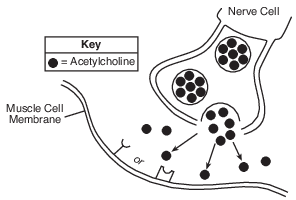Topic: Cellular Communication
Cellular Communication
The diagram below represents cells and hormones present in the human body.

Which statement correctly describes an interaction between the hormones and the cells?
(1) Hormone A is synthesized by cell 2 and targets cell 1.
(2) Hormone B bonds with both cell 1 and cell 2.
(3) Specific reactions carried out by cell 1 are regulated by hormone C.
(4) The specialized receptor molecules on cell 1 secrete hormone B.
The molecules represented in the diagram below can interact to cause a biochemical process to occur.

Molecule A and molecule B most likely represent
(1) a nerve signal and a gene
(2) a receptor and a hormone
(3) a chromosome and an antigen
(4) a starch and an amino acid
The inability of an organism to produce certain proteins can occur when an organism is lacking an enzyme needed to combine
(1) oxygen molecules
(2) simple sugars
(3) amino acids
(4) biological catalysts
Molecules in a certain medication attach to receptors on nerve cells. This prevents the normal chemical signal from binding to the receptor. One immediate result of taking this medication might be a disruption in the ability of
(1) the body to produce reproductive cells
(2) cells to communicate with each other
(3) cells to synthesize proteins
(4) the body to convert inorganic material into organic nutrients
Botulinum toxin is a substance that can cause paralysis in humans. The effects of the toxin are due to the blocking of a signaling molecule that is necessary for communication between nerve cells. The toxin most likely interferes with the normal functioning of a
(1) chromosome
(2) DNA molecule
(3) receptor
(4) digestive hormone
Anabolic Steroids
Anabolic steroids are hormones that affect muscle growth. Many athletes take synthetic anabolic steroids, in hopes of developing larger muscles so they can perform better at their sport. These hormones can act like the hormone testosterone. When men take an excess of anabolic steroids, they can have an increase in feminine features. This is due to the fact that the excess of these chemicals signals the male body to stop producing testosterone.
One reason why anabolic steroids can imitate the hormone testosterone is because
(1) anabolic steroids and testosterone both interact with the same cell receptors
(2) testosterone acts only on muscle cells
(3) females produce small amounts of the hormone testosterone
(4) an increase in testosterone in males using anabolic steroids increases male features
Diabetes is a condition characterized by elevated blood sugar levels. One form of diabetes occurs when insulin fails to properly regulate blood sugar levels. Complications from diabetes can include nerve cell damage and poor blood flow, especially in the feet and legs. In individuals with diabetes, wounds usually take longer than normal to heal.
The failure of a cell to react in a normal manner to insulin is most likely the result of a problem with
(1) vacuoles
(2) receptors
(3) mitochondria
(4) sugars
How do cells in the ovary detect a hormone from the brain?
(1) The brain sends a nerve impulse to the ovary.
(2) White blood cells bring the hormone to the ovary.
(3) Receptor molecules on the cells of the ovary bind with the hormone.
(4) Vacuoles within the ovary bind with the hormone.
The breathing rate, heart rate, and blood hormone levels of an individual would directly provide information about that individual’s
(1) cellular organization
(2) nutrition
(3) inheritance
(4) metabolic activity
Which statement concerning cell communication is correct?
(1) DNA codes for certain molecules that become cell receptors involved in cell communication.
(2) Cells produce ATP molecules, which become cell receptors for communication.
(3) Cells build new cell parts, which function as communication genes.
(4) Certain proteins use cell communication to build new cell parts made of DNA.
The diagram below represents the region between two nerve cells. Cell A releases a chemical that travels to and binds with structure X on cell B.

Structure X most likely represents
(1) a receptor molecule
(2) an inorganic substance
(3) a ribosome
(4) an antibody
Many hormones are proteins used in cellular communication. Each hormone carries a specific message to specific target cells. State why each of these hormones is able to deliver a different message. [1]
Allow 1 credit. Acceptable responses include, but are not limited to:
• — Each hormone has a different shape and attaches to a specific receptor.
• — Hormones differ in their shapes. If this shape were changed, the molecule would not send
• the necessary message to the cell.
• — Different sequences of amino acids make different hormones, giving them a unique shape.
• — Cell receptors are specific for certain hormones.
Botulinum toxin is a protein produced by the bacterium Clostridium botulinum. It causes a serious form of food poisoning in humans. In a very dilute form, it is also commonly used to eliminate some signs of aging, such as wrinkles. It does this by preventing nerves from releasing a chemical messenger called acetylcholine into the synapse (space between a nerve cell and a muscle cell). The toxin affects the process that causes the muscle cell to contract and form wrinkles.
The diagram below represents a process that is involved in the formation of wrinkles. Complete the diagram by drawing an appropriate structure on the muscle cell membrane that would allow the nerve cell to communicate with the muscle cell. [1]

Allow 1 credit.
• Example of a 1-credit response:
• 
• Note: Acceptable responses include a receptor drawn on the muscle cell membrane that has a
• shape that acetylcholine could fit into.
A typical human liver cell can have over 90,000 insulin receptors. Due to a genetic difference, some people have liver cells that contain only about 1000 insulin receptors.
Describe the importance of receptors in cellular communication. [1]
Allow 1 credit. Acceptable responses include, but are not limited to:
• — Receptors receive messages sent by other cells.
• — They enable cells to respond appropriately.
When fish of certain species are injured, a chemical substance stored in skin cells of the fish is released into the water. This chemical causes an alarm response among other fish of the same species in the area. Nearby fish of this species become more alert and group together near the bottom.

Explain why the chemical released from the injured fish may not cause an alarm response in other fish species. [1]
Allow 1 credit. Acceptable responses include, but are not limited to:
• — Other species lack the receptors for the chemical.
• — The alarm chemicals are specific to the species.
• — Other species lack the ability to sense/recognize the chemical.
